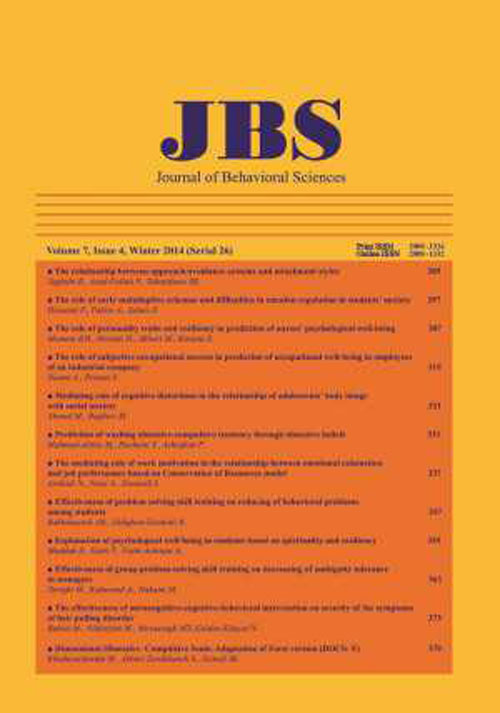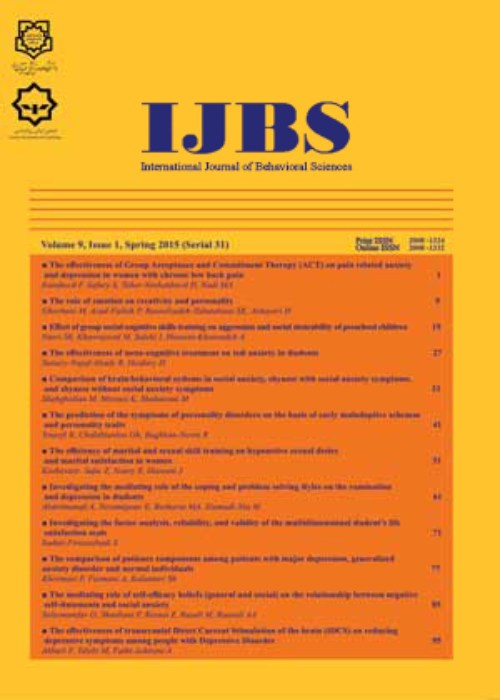فهرست مطالب

International Journal of Behavioral Sciences
Volume:11 Issue: 4, Winter 2018
- تاریخ انتشار: 1396/12/01
- تعداد عناوین: 7
-
-
Pages 128-134IntroductionSelf-handicapping is a defense strategy in which a person, prior to any performance, creates some obstacles by which he manipulates his attributions after the performance. This variable is regarded as one impediment to educational efficiency. This study aims to design a training package to foster stable self-esteem and reduce the fear of negative evaluation to influence teenagers’ self-handicapping.MethodTo this end, based on an empirical research study and after the confirmation of the validity of the designed training package by experts (p<0.001), one high school was selected through convenience sampling method from among Junior high schools. The population of eighth grade high schoolers (150) answered to Jones Self-Handicapping Scale (1982), Brief Form of the Fear of Negative Evaluation Scale (FNES-B) and Instability of Self-Esteem Scale (ISES). From among the foregoing population, a group of 60 high schoolers with an average age of 14 years old who had obtained the highest self-handicapping scores were randomly assigned to two experimental and control groups and received the training package for 8 one-hour sessions. Then, a post-test and a follow-up test were administered after one subsequent month. Data was analyzed using the regression analyze, independent-t method and mixed analysis of variance.ResultThe study results suggested the effectiveness of the training package in promoting the stable self-esteem and reducing the fear of negative evaluation and consequently reducing self-handicapping scores of the subjects (p<0.001,partial η²= 0/315).ConclusionThis study proposes that, owing to the criticality of adolescence, training packages focusing on fostering stable self-esteem and decreasing fear of negative evaluation may be highly effectual in alleviating adolescents’ self-handicapping and operate as a factor leading to more development and growth for them.Keywords: Education, Fear, evaluation, Self-esteem, adolescents
-
Pages 135-141IntroductionInfidelity can have devastating effects on the couple and other important people in couple's life. So many researches are dedicated to examine the predictors of infidelity, however reaction to the infidelity is still an unknown issue; although it has important roles in couple's interaction following discovery, psychological and physiological wellbeing of the person, husband and children. Hence, this study was conducted with the purpose of examining people's reaction to the infidelity in Iranian couples.MethodsPresent study was a qualitative research with the approach of phenomenology. People with the experience of spouse's infidelity were invited to participate in a psychological research through public notice. Purposive sampling continued till the saturation of data was achieved. Through this procedure 16 people were interviewed. The in-depth semi structured interview was used to explore participant's reactions to the infidelity.ResultsIn this research, the Colaizzi's method was used to analyze the data. After transcribing the interviews, formulated meanings were extracted. Within analyzing process, these formulated meanings were classified in 12 theme clusters. Finally 5 major themes emerged: Reactions to oneself, reactions to spouse, reactions to spouse's family of origin, reactions to third person, and reactions to others (own family, children and friends).ConclusionsFindings were consistent with theories which conceptualize reaction to the infidelity as the traumatic response. But the clusters of reactions to spouse family of origin and physiological reactions are the specific outcomes of this research.Keywords: couple, infidelity, Iranian sample, Phenomenology, qualitative research
-
Pages 142-146Background & aimPsychological capital is one of the new concepts discussed nowadays. In fact, the design of this approach reflects its significance in the field of social capital. This study aims to investigate the effectiveness of teaching democratic relationships to parents on female high school students’ psychological capital.Materials and methodsThe present study was conducted through the quasi-experimental method using pre and posttest and control group. The statistical population of this study includes all mothers and female high school students residing in district 4 of Tehran city in 2015-16, from which, 42 subjects were selected using the cluster random method, and finally they were randomly placed in two groups with 21 members (control and experiment). Research data was collected using Luthans psychological capital questionnaire. The experimental group attended ten 90-minute sessions of democratic relationships training, while the control group attended none. The collected data was analyzed using ANCOVA in descriptive statistics.FindingsFindings indicate that there is a significant difference in the psychological capital of the control and experimental group, showing that teaching democratic relationships to mothers was effective in increasing their daughters’ psychological capital.ConclusionBased on the mentioned findings, it can be concluded that psychological capital is a personality trait with growing and developing capabilities, and it is affected by several factors including teaching democratic relationships to parents.Keywords: psychological capital, teaching democratic relationships, Female Students
-
Pages 147-151IntroductionThe purpose of this research was to investigate role of defense styles and defense mechanisms in prediction of features of borderline personality in non-clinical samples.MethodsIn this descriptive correlation study, 378 undergraduate students (181 males, 197 females) from the statistical population of students from all sections of Arak University during 2015 were selected through cluster random sampling method and filled in the questionnaire of style defense and Borderline Personality Scale. Data analysis was performed using correlation, regression analysis and analysis of variance.ResultsThe results indicated that features of borderline personality had a significant positive correlation with neurotic and immature defenses, and there was no significant relationship between features of borderline personality and mature defenses. Regression analysis showed that immature defenses could predict features of borderline personality. The results also revealed, five defenses (acting out, autistic fantasy, splitting, passive aggression and displacement) could predict features of borderline personality.ConclusionBased on the results of the present stud, it can be concluded that immature defenses predicted higher levels of features of borderline personality.Keywords: features of borderline personality, defense styles, Defense Mechanisms
-
Pages 152-159IntroductionThe aim of study is to establish the relationship between the anxiety, depression and quality of life levels and the relationships in the early postpartum period of mothers.MethodsCross-sectional study has been conducted with 162 mothers consulting to Family Health Centre (FHC) during the first week of postpartum. The present study has been conducted through interview method in 6 FHCs selected among 24 FHCs among systematic sampling method. Personal Introduction Form, Centre for Epidemiologic Studies’ Depression Scales, Beck Anxiety Inventory and the World Health Organization Quality of Life Scale have been filled out for those who accepted to join the survey.ResultsPostpartum depression risk has been found 33.3% and average anxiety score has been found 11.12±7.58. There is a significant negative correlation between the average scores the level of depression and anxiety, and sub-dimensions of the quality of life scale (physical r= -0.302, p=0.000/ r= -310, p=0.000; mental r= -0.606, p=0.000/ r= -0.426, p=0.000; social r= -0.209, p=0.008/ r= -0.227, p=0.004; national environmental r= -0.210, p=0.007/ r= -0.170, p=0.031).DiscussionAs the depression and anxiety levels of mothers in the postpartum period, sub-dimensions of the psychological, physical, social and national dimensions the quality of life scale are affected adversely.Keywords: Anxiety, depression, Quality of Life, Postpartum Period, Midwifery
-
Pages 160-165IntroductionThe tendency to addiction appears more in adolescence and early adulthood than any other stages of a human life. The study of variables affecting addiction have always been of interest to researchers. This study aims to investigate the relationship between borderline personality disorder as a facilitating and mindfulness as an inhibiting factor in adolescents’ tendency to addiction.MethodThe study employed a correlation method. A group of 579 first year undergraduate students of Arak University in 2016 were selected using purposeful sampling method. The participants were asked to answer a demographic questionnaire, Five Facet Mindfulness Questionnaire (FFMQ), Borderline Personality Part of Schizotypal Personality Scale, and the Iranian Addiction Potential Scale. The Data were analyzed using Spearman's rank correlation coefficient and the stepwise multiple regression.ResultsThe results of the Spearman's rank correlation coefficient indicated significant (p<0.05) correlation between the borderline personality and mindfulness, and the tendency to addiction. The results of the multiple regression also indicated that the borderline personality and mindfulness explain 30% of the passive addiction potential variance to gather (R2 =0.30, p< 0.01), and the borderline personality alone explains 23% of the active addiction potential variance (R2 =0.23, p<0.01) and 31% (R2 =0.31, p<0.01) of the total variance of tendency to addiction, but the role of mindfulness active addiction potential was not significant (p>0.05).ConclusionIn sum, the results indicated that the borderline personality disorder and mindfulness symptoms together could significantly predict the tendency to addiction in adolescents. However, the borderline personality has more contribution than mindfulness.Keywords: Adolescence, Borderline Personality, Mindfulness, Tendency to Addiction
-
Pages 166-171AimThe present study was conducted to compare the effectiveness of video prompting and self-video modelling on the reduction of autistic children's symptoms.MethodsThe method of this research was using a quasi-experimental method using two experimental groups and one control group. The statistical population of this study included children with autism disorder aged 4-8 years who were treated at the Tehran Autism Centre from 2015 to 2017. According to the nature of this research, available sampling and random placement were used. At the end, 18 children were selected and randomly assigned into two experimental groups and a control group according to the inclusion criteria. Two video pieces that were previously prepared for teaching social communication skills in both video prompting and self- modelling were presented to participants during 24 sessions which lasted for 30 minutes. Prior to and after the intervention, the participants were tested for the skills mentioned above. The research instrument consisted of the Gilliam Autism Ranking Scale (Gares), Questionnaire of Sensory Profile, Video Modelling Intervention, and Self-Video Modelling Intervention. Collected data were analysed using MANCOVA test and Bonferroni's post hoc test and analysed by SPSS 24.ResultsAfter ensuring the non-violation of statistical assumptions and based on the results of MANCOVA test, there is a significant difference between the three groups in the post-test, in the areas of communication and interaction. Also, there was no significant difference between the three groups in the emotional responses in the post-test scores with the moderation of pre-test effect. Also, the results of Bonferroni's post hoc test indicated that there is no significant difference between the two methods.ConclusionsThe findings of this study emphasize the effectiveness of video prompting and self-video modelling on the reduction of communication and interaction problems of autistic children. Also, video modelling improves language deficiencies and restrictions, communication skills, verbal and nonverbal conversations, control of repetitive behaviours, spontaneous verbal requests, application commands, and daily life skills.Keywords: Autism Spectrum, Video Prompting, Self-video Modelling, Communications, Interactions


